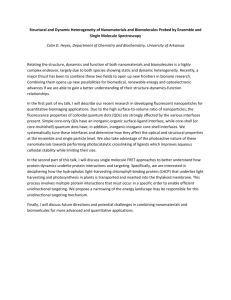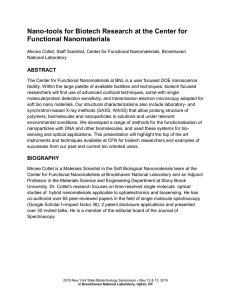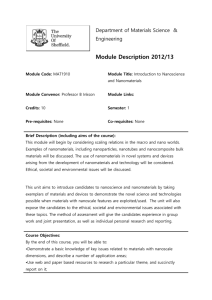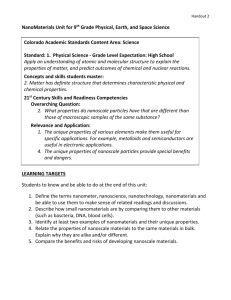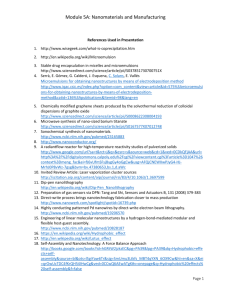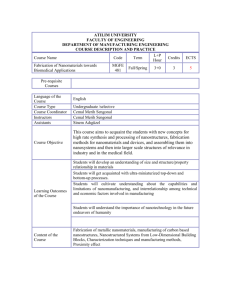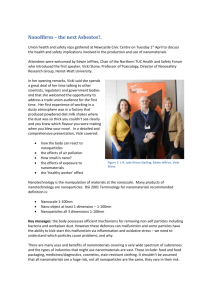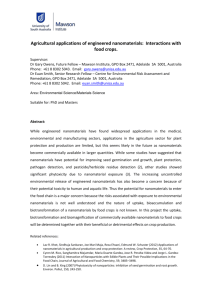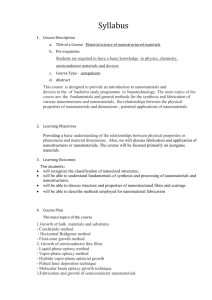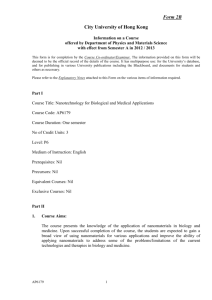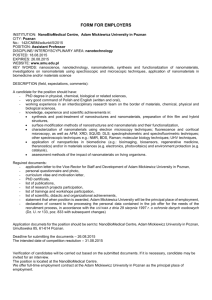applications of nanomaterials
advertisement
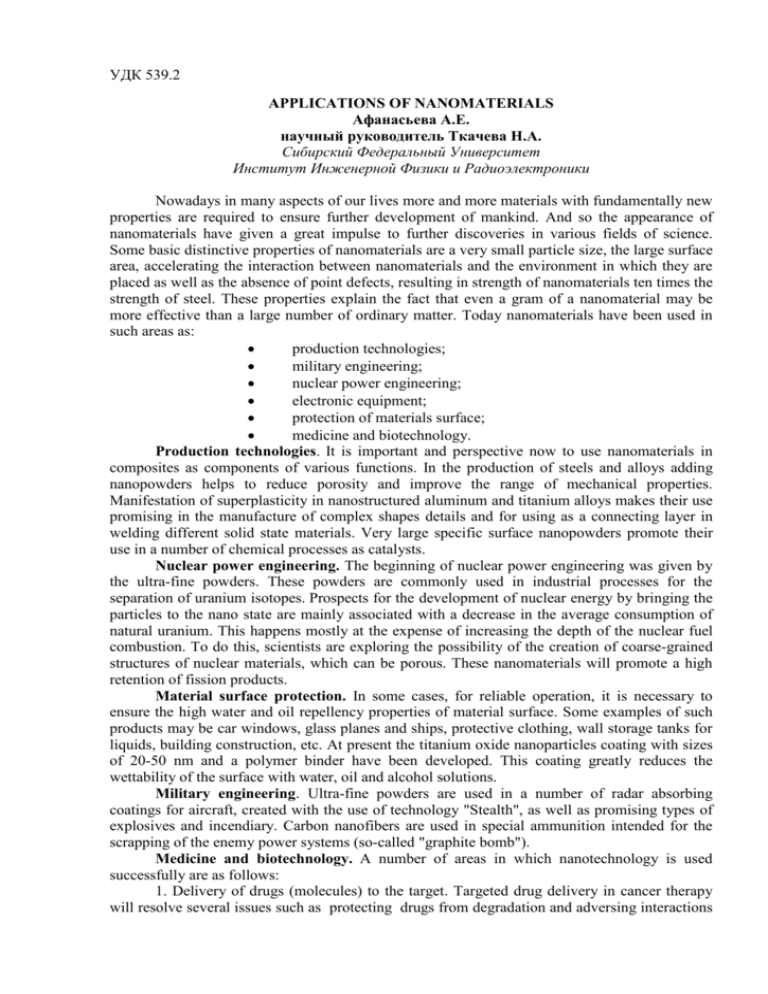
УДК 539.2 APPLICATIONS OF NANOMATERIALS Афанасьева А.Е. научный руководитель Ткачева Н.А. Сибирский Федеральный Университет Институт Инженерной Физики и Радиоэлектроники Nowadays in many aspects of our lives more and more materials with fundamentally new properties are required to ensure further development of mankind. And so the appearance of nanomaterials have given a great impulse to further discoveries in various fields of science. Some basic distinctive properties of nanomaterials are a very small particle size, the large surface area, accelerating the interaction between nanomaterials and the environment in which they are placed as well as the absence of point defects, resulting in strength of nanomaterials ten times the strength of steel. These properties explain the fact that even a gram of a nanomaterial may be more effective than a large number of ordinary matter. Today nanomaterials have been used in such areas as: production technologies; military engineering; nuclear power engineering; electronic equipment; protection of materials surface; medicine and biotechnology. Production technologies. It is important and perspective now to use nanomaterials in composites as components of various functions. In the production of steels and alloys adding nanopowders helps to reduce porosity and improve the range of mechanical properties. Manifestation of superplasticity in nanostructured aluminum and titanium alloys makes their use promising in the manufacture of complex shapes details and for using as a connecting layer in welding different solid state materials. Very large specific surface nanopowders promote their use in a number of chemical processes as catalysts. Nuclear power engineering. The beginning of nuclear power engineering was given by the ultra-fine powders. These powders are commonly used in industrial processes for the separation of uranium isotopes. Prospects for the development of nuclear energy by bringing the particles to the nano state are mainly associated with a decrease in the average consumption of natural uranium. This happens mostly at the expense of increasing the depth of the nuclear fuel combustion. To do this, scientists are exploring the possibility of the creation of coarse-grained structures of nuclear materials, which can be porous. These nanomaterials will promote a high retention of fission products. Material surface protection. In some cases, for reliable operation, it is necessary to ensure the high water and oil repellency properties of material surface. Some examples of such products may be car windows, glass planes and ships, protective clothing, wall storage tanks for liquids, building construction, etc. At present the titanium oxide nanoparticles coating with sizes of 20-50 nm and a polymer binder have been developed. This coating greatly reduces the wettability of the surface with water, oil and alcohol solutions. Military engineering. Ultra-fine powders are used in a number of radar absorbing coatings for aircraft, created with the use of technology "Stealth", as well as promising types of explosives and incendiary. Carbon nanofibers are used in special ammunition intended for the scrapping of the enemy power systems (so-called "graphite bomb"). Medicine and biotechnology. A number of areas in which nanotechnology is used successfully are as follows: 1. Delivery of drugs (molecules) to the target. Targeted drug delivery in cancer therapy will resolve several issues such as protecting drugs from degradation and adversing interactions with biological molecules, increasing the selectivity of drug absorption by tumor cells, controlling of pharmacokinetics, increasing bioavailability of drugs into tumor cells. Apart from the drugs nanoparticles can deliver genes into cells. 2. Treatment and prosthetics using nanomaterials. The unique properties of nanomaterials allow to produce various implants and dentures. With the use of nanotechnology we can get safe, biocompatible and durable implants. 3. Diagnostics. The development of nanotechnology in biomedicine due to improved technology helps to obtain the images, characterization and analysis of biological material, providing a high degree of resolution. Magnetic nanomaterials are an important source for the production of biosensors. The most commonly used nanoparticles are based on the iron oxide coated with various polymers. The surface can be modified by various biospecific ligands as well. Thus the shell protects the iron oxide nanoparticles from chemical interaction with molecules of cells and tissues. Some nanomaterials are also used as electrochemical sensors (nanotubes and nanoparticles) for diagnostics. Electronic equipment. Nanotechnology in Electronics were given a boost by using carbon nanotubes. They are not only able to replace the transistors, but also give the revolutionary electronic circuits their new mechanical and optical properties, that is to create flexible and transparent electronics. The nanotubes are more mobile and do not hold the light in a thin layer, so that the experimental matrix integrated circuit can be bent without loss of the electronic properties. Another application of nanotechnology in electronics is the creation of a new type of hard disks. In 2007, the Nobel Prize in Physics was awarded to Peter Grünberg and Albert Fert for the discovery of the giant magnetoresistance effect, or, as some authors call it, GMR-effect. On the basis of this effect, it is possible to create magnetic field sensors that can exactly read the information recorded on the hard disk with almost the atomic density. One more prospective application of nanomaterials is producing solar cells. The solar cells that are made on the basis of nanowires instead of the traditional metal wires, can increase fifteen times the amount of energy received by a battery. Conductor nanoscale has unique properties of the light absorption. Using nanostructured materials in the manufacturing of the solar cells can improve their efficiency and reduce their cost. Список литературы 1. Б.М. Балоян, А.Г. Колмаков, М.И. Алымов: Наноматериалы. Классификация, особенности свойств, применение и технологии получения. Учебное пособие. М., - 2007. 2. Агентство ПроАтом: Нанотехнологии в энергетике. URL: http://www.proatom.ru 3. Нанотехнологическое сообщество Нанометр: Нанотехнология для медицины. URL: http://www.nanometer.ru 4. Нано Дайджест: Нанотехнологии в электронике. URL: http://nanodigest.ru 5. Материаловед: Наноматериалы и их свойства. URL: http://материаловед.рф 6. Nano News Net: Нанопроволочные элементы — основа солнечных батарей будущего. URL: http://www.nanonewsnet.ru
